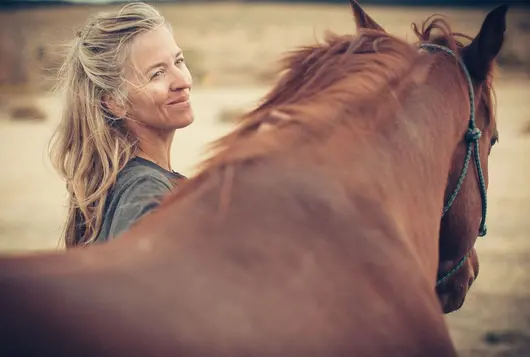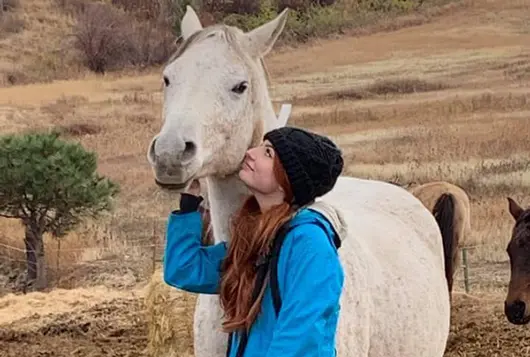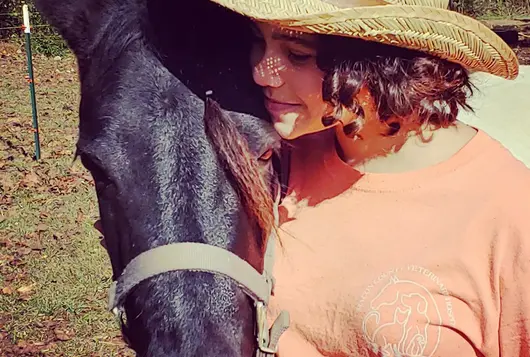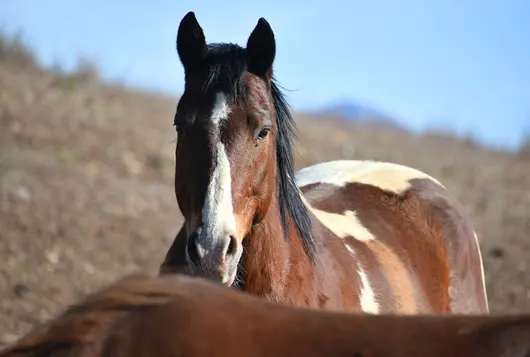How Training Can Help Equine Welfare Organizations Increase Adoptions

Bishop, left, with trainer Adam Black, and Jonsey Boy, who was trained by Jeremy Earehart.
Training is often the resource that can make the biggest difference in helping an adoptable horse find their human match. Though training resources are often scarce, two innovative groups have developed creative programs to engage trainers and expand their capacity to help equines.
Training Success Stories
Bishop, an 8-year-old American Quarter Horse/Spotted Saddle Horse cross, was rounded up close to a Kentucky coal mine in 2021. He arrived at Heart of Phoenix Equine Rescue (HOP), a West Virginia nonprofit, and was gelded and placed with a trainer. After months of training and preparation, Bishop competed in a unique training challenge called the Appalachian Trainer Face-Off in 2022.
“Bishop’s trainer, Adam Black, did an amazing job with him,” says Tinia Creamer, Executive Director of HOP and a former ASPCA Equine Welfare Award winner. “Originally a feral stallion, he ultimately achieved success under-saddle and placed well in the competition.”
Bishop was placed in a home in New England, but the pair did not end up being a good match, so he was returned. Bishop was then placed with a youth trainer, Dixie Marrese, who competes in the Extreme Mustang Makeover. “Bishop’s story speaks to the need for a diverse trainer base, for equines with varying backgrounds,” says Tinia. Bishop was eventually adopted by a long-time horsewoman and instructor, Laurel Ann Moore. “It’s a wonderful pairing,” Tinia says. “But it took trainers, partnerships, and being invested in the horse to get him there.”
At Horses’ Haven, a Michigan nonprofit, Jonsey Boy, a 15-year-old Thoroughbred, was physically rehabilitated for weight, farrier, and skin issues. He also had challenging behavioral issues. “He was extremely reactive to basic handling, biting and kicking to the point that we used him in our Law Enforcement Clinic as an example of how to read threatening body language,” says Kristine Dvonch, Executive Director of Horses’ Haven. “We had him listed as a ‘rehab team handle only’ to protect our volunteers.”
Aggressive on the lunge line and under saddle, the enormous 17hh gelding bucked, would not move forward, and would even take advantage of his long neck to bite a rider’s legs. After ruling out medical issues, Horses’ Haven transferred Jonsey to a trainer with the skill set to handle his behavioral issues and who gave him attention 7 days a week.
Jonsey and his trainer, Jeremy Earehart of Radiant Eve Stables, were successful in setting boundaries and working through his issues, and one of Jeremy’s staff ended up adopting Jonsey. “It was a 4-month training journey,” says Kristine. “But it would have taken much longer if he had stayed on site with us.”
Horses’ Haven’s in-house trainers spend five days a week with the horses. Even so, training resources are still scarce, so they’ve come up with an innovative model to expand their training network within their budget. “Once the trainers get the horses, they’re responsible for them financially,” says Kristine. “The trainer sets the adoption fee and places the horse under our contract. When they place the horse, they keep the adoption fee. It’s a win-win.”
A Need for Training
Stories like Bishop’s and Jonsey’s illustrate the huge need for horse rescue and equine welfare organizations to partner with professional trainers to increase adoptions. “Lack of training is one of the biggest barriers in equine adoption and successful placement,” says Kristine. “The majority of adopters are not equipped with the skills to train a horse and 75% of our adopters are looking for a horse they can ride. Even a non-rideable horse has a much better chance at adoption with training to be a good equine citizen.”
Kristine adds that Horses’ Haven houses up to 70 equines at any given time, with the capacity to have up to 20 in training, with a split of 10 in groundwork and 10 in under-saddle work. “One of the main reasons equine welfare organizations can have a hard time placing horses is many of their horses have never been under saddle, and equine adopters usually want a horse they can ride,” says Kristine.
Heart of Phoenix Equine Rescue keeps its population at about 125—up to 45 in their facility and the rest in foster pastures. “99% of our horses need some degree of training,” says Tinia, who relies on professional trainers for at least 50% of her population, and experienced fosters to help train the rest. “We use professionals primarily for horses who have never been under saddle. Some horses with problems come from people who mean well but lack skills, so the trainer must unravel all that.”
“Training is an important topic that’s always come up in conversations,” says Cailin Caldwell, Director of the ASPCA Right Horse program, a collective of industry professionals, organizations, and advocates collaborating to increase the number of successful horse adoptions. In collaboration with over 60 industry and adoption partners, including HOP and Horses’ Haven, the ASPCA also has a network of trainers they connect with ASPCA Right Horse partners.
“Lack of training is one of the biggest barriers in equine adoption and successful placement. The majority of adopters are not equipped with the skills to train a horse but want a horse they can ride.”
Tips for Collaborating with Trainers
- Have open conversations. Invite potential trainers to stables and seek opportunities to talk about your organization, such as speaking engagements or special events. Kristine’s advice: Know your metrics, know your horses, and know your mission, and talk about that.
- Be ready and organized. Make sure your organization is where it needs to be before approaching trainers. Have a well-running structure to set up trainers to be successful collaborators. Otherwise, if a trainer shows up and the support system isn’t there, your reputation suffers.
- Know the horse before you engage a trainer. Vet your horses medically and ensure they are healed and ready to begin training. Also, spend at least a week or so working with them to better understand their needs. Develop profiles for the horses so trainers can determine if their program fits the horse’s needs.
- Encourage fostering and volunteering. Having experienced horse volunteers is very important. Make everyone who’s ever had horses feel like they, too, can volunteer or foster. “If people have horses, they should also consider fostering. I’ll offer to cover certain costs or offer a horse for a short-term foster stint—like maybe for summer —to make fostering more accessible,” says Tinia.
- Make trainers and foster caregivers feel valuable. Experienced volunteers and fosters can go a long way in avoiding the need for a professional. “We can’t do what we do without trainers, so we’re sure to communicate how much they’re valued,” says Tinia, who also relies heavily on foster support. “A lot of horses in rescue have been handled and just need a good horse person for 3 months to get where they need to be. Plus, fosters give care and their pastures for free; otherwise, holding costs can be astronomical.”
- Be inclusive. Always communicate how you’re equal partners who need each other in the industry.
- Create competitive events. In 2017, HOP created the Appalachian Trainer Face-Off—for which the ASPCA has provided grant funding—to recruit and incentivize trainer participation in equine welfare. The competition has become a prestigious event where trainers like Adam compete and showcase their accomplishments with their horses. This year, HOP had 40 horses in the competition.
“We started the event to creatively provide more training to more horses, as well as grow our trainer base,” says Tinia. “It gets them in front of big-name judges, gives them the chance to win cash prizes, and the trainer receives half of the adoption fee, which often more than pays for the time they spent with that horse.”
- Use social media. “If I have a horse that needs training and I post about it on social media, nine times out of 10 someone will raise their hand to help,” says Tinia. “We cover the vet fees, farrier, and feed costs, and we help trainers learn how to build their businesses on their social media platforms.”
- Encourage trainers to network horses. One of the primary goals of engaging horse trainers is to find a wonderful home for your horse by advancing their skill set and expanding their network. Encourage your training partners to market the horses they’re working with, and don’t be afraid to market them early in the training process. There may be an adopter with the skills to continue the training, or an adopter may choose to adopt and continue the program. It’s a win, win: the adopter gets a great horse, the horse finds a wonderful home, and the shelter doesn’t need to continue to cover training fees.
- Advise new adopters to keep training. Encourage newer horse owners to take lessons and work with a trainer to continue their equine education. Support them along their journey, including offering onsite clinics to support both the horse and adopter. For a young or newly trained horse, highlight the importance of continued training in adoption counseling.
We have lots more on this subject:



